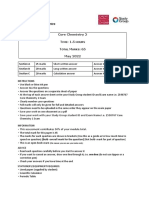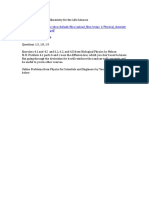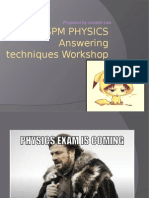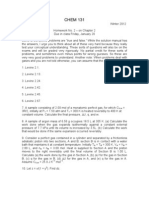CHEM 371 A1/EA1: Problem Set 1 Due by 1:00 PM, Monday September 25
Uploaded by
Akib ImtihanCHEM 371 A1/EA1: Problem Set 1 Due by 1:00 PM, Monday September 25
Uploaded by
Akib ImtihanCHEM 371 A1/EA1: Problem set 1
Due by 1:00 pm, Monday September 25
Part A: Textbook Suggested Problems
These problems will not be collected and graded. However, you should try them since they will help
with your understanding of the material. If you have any difficulties, please see me. [NOTE: I have
suggested the part (b) Exercises; however, fully-worked solutions to the analogous part (a) Exercises, and
odd-numbered Problems, are available in the Student Solutions Manual.]
Exercises from the textbook: 1A.1(b), 1A.2(b), 1A.4(b), 1A.5(b), 1A.8(b), 1B.1(b), 1C.1(b), 1C.3(b),
1C.4(b), 1C.9(b)
Problems from the textbook: 1A.1, 1A.6, 1A.7, 1B.6, 1C.21
Exercises get you familiar with the basic physical understanding and use of the relevant equations. Problems
usually, but not always, require more careful consideration.
Part B: Suggested problems
These problems will not be collected and graded. However, you should try them since they will help with
your understanding of the material. If you have any difficulties, please see me.
1. The density of a gas sample is 1.03 g L−1 at 311 K and 161 Torr. What is the molar mass in g mol−1 ?
2. Calculate the ratio of mean speeds of He over Hg atoms at 630.0 K. Does the ratio depend on
temperature?
3. What pressure (in bar) would be predicted for 0.8 dm3 of Cl2 weighing 17.5 g at 273.15 K using the
van der Waals equation? NOTE: Please use van der Waals data for Cl2 from the textbook.
Part C: Assigned problems
This problem will be collected and graded. You must show your work and provide a final numerical answer
with appropriate units and a reasonable number of significant figures. In order to receive marks for the
final answer, you must indicate it clearly by placing a box around the answer.
1. The total pressure of a mixture of oxygen and hydrogen is 1.00 atm. The mixture is ignited and
the water is removed. The remaining gas is pure hydrogen and exerts a pressure of 0.400 atm when
measured at the same values of T and V as the original mixture. What was the composition (in
terms of mole fraction or mole percent of oxygen and hydrogen) of the original mixture? Clearly
state any assumptions you make in your solution.
You might also like
- M1 Lesson 5 Assignment Part 1:: Lab 1: Molar Heat of NeutralizationNo ratings yetM1 Lesson 5 Assignment Part 1:: Lab 1: Molar Heat of Neutralization4 pages
- AP-Chem-2nd-Ed-Student-FINAL-DIGITAL-Activity-33-Solving-Equilibrium-ProblemsNo ratings yetAP-Chem-2nd-Ed-Student-FINAL-DIGITAL-Activity-33-Solving-Equilibrium-Problems8 pages
- Periodic Table Atomic Structure Measurement Calculation Concept Maps PracticeNo ratings yetPeriodic Table Atomic Structure Measurement Calculation Concept Maps Practice17 pages
- SG Quiz11 65daab5dec4336.65daab5fa4a4c5.36829103No ratings yetSG Quiz11 65daab5dec4336.65daab5fa4a4c5.3682910310 pages
- AC Lab 4 Molecular Weight Freezing Point DepressionNo ratings yetAC Lab 4 Molecular Weight Freezing Point Depression10 pages
- Practice Stoichiometry Test (V1 Jan 2019) FINALNo ratings yetPractice Stoichiometry Test (V1 Jan 2019) FINAL14 pages
- Practice Exam #1 Chemistry 5.12 Organic ChemistryNo ratings yetPractice Exam #1 Chemistry 5.12 Organic Chemistry7 pages
- S3 Physics 2016 17 HEAT Students Dec2016No ratings yetS3 Physics 2016 17 HEAT Students Dec201688 pages
- EXPERIMENT 6: Photometric Determination of An Equilibrium ConstantNo ratings yetEXPERIMENT 6: Photometric Determination of An Equilibrium Constant9 pages
- Bengkel Pecutan Fizik SPM - (Teknik Menjawab Soalan)100% (3)Bengkel Pecutan Fizik SPM - (Teknik Menjawab Soalan)167 pages
- Final Example: Answer: A. This Is Because in This Reaction, Cu Goes From 2+ in Cuo To 0 in Cu (S) - SoNo ratings yetFinal Example: Answer: A. This Is Because in This Reaction, Cu Goes From 2+ in Cuo To 0 in Cu (S) - So9 pages
- Practicehalfsyllabustest - D21 Sept 2023No ratings yetPracticehalfsyllabustest - D21 Sept 20235 pages
- CBE 141-Chemical Engineering Thermodynamics Spring 2015No ratings yetCBE 141-Chemical Engineering Thermodynamics Spring 20154 pages
- Grade 12 Physical Sciences Test 3 26 June 2022No ratings yetGrade 12 Physical Sciences Test 3 26 June 202220 pages
- Student Solutions Manual for Mathematics for Economics, fourth editionFrom EverandStudent Solutions Manual for Mathematics for Economics, fourth editionNo ratings yet
- CHE 374 - Computational Methods in Engineering: Topic Chapter Ref. in TextbookNo ratings yetCHE 374 - Computational Methods in Engineering: Topic Chapter Ref. in Textbook1 page
- Sample First Midterm Exam CHEM 101/103, Section Z9 Date of Exam, 12:00 - 12:45No ratings yetSample First Midterm Exam CHEM 101/103, Section Z9 Date of Exam, 12:00 - 12:456 pages
- Computational Methods in Engineering Che 374No ratings yetComputational Methods in Engineering Che 3746 pages
- Chem 10X Data Sheet: 1. Periodic Table of The ElementsNo ratings yetChem 10X Data Sheet: 1. Periodic Table of The Elements2 pages
- Solve The Following Problems by Hand. When Needed, Use A Calculator!No ratings yetSolve The Following Problems by Hand. When Needed, Use A Calculator!1 page
- MATLAB Basics: CHE 374 Computational Methods in EngineeringNo ratings yetMATLAB Basics: CHE 374 Computational Methods in Engineering10 pages
- CHE 374 Computational Methods in Engineering: NumbersNo ratings yetCHE 374 Computational Methods in Engineering: Numbers6 pages
- CH E 374 Computational Methods in EngineeringNo ratings yetCH E 374 Computational Methods in Engineering4 pages
- MATLAB - OnTheHub - License-Download-Install GuideNo ratings yetMATLAB - OnTheHub - License-Download-Install Guide2 pages
- Section 3: The Second and Third Laws Section 3A EntropyNo ratings yetSection 3: The Second and Third Laws Section 3A Entropy2 pages
- Section 2D. State Functions and Exact DifferentialsNo ratings yetSection 2D. State Functions and Exact Differentials4 pages
- H H C O mol C O mol: H H + Δ H + Δ H = 7.5192 kJ + 40.656 kJ − 3.358 kJ = 44.83 kJNo ratings yetH H C O mol C O mol: H H + Δ H + Δ H = 7.5192 kJ + 40.656 kJ − 3.358 kJ = 44.83 kJ5 pages
- Welcome To CHEM 371: Energetics of Chemical Reactions: TextsNo ratings yetWelcome To CHEM 371: Energetics of Chemical Reactions: Texts3 pages
- P F A NMV V P NM V V V: Example: Calculate The Rms Speed of He Atoms at 298 KNo ratings yetP F A NMV V P NM V V V: Example: Calculate The Rms Speed of He Atoms at 298 K3 pages
- Section 1: The Properties of Gases: PV NRT R N KNo ratings yetSection 1: The Properties of Gases: PV NRT R N K3 pages
- 1C.2 The Van Der Waals Gas: P NRT V NB V P RT V VNo ratings yet1C.2 The Van Der Waals Gas: P NRT V NB V P RT V V2 pages

























































































